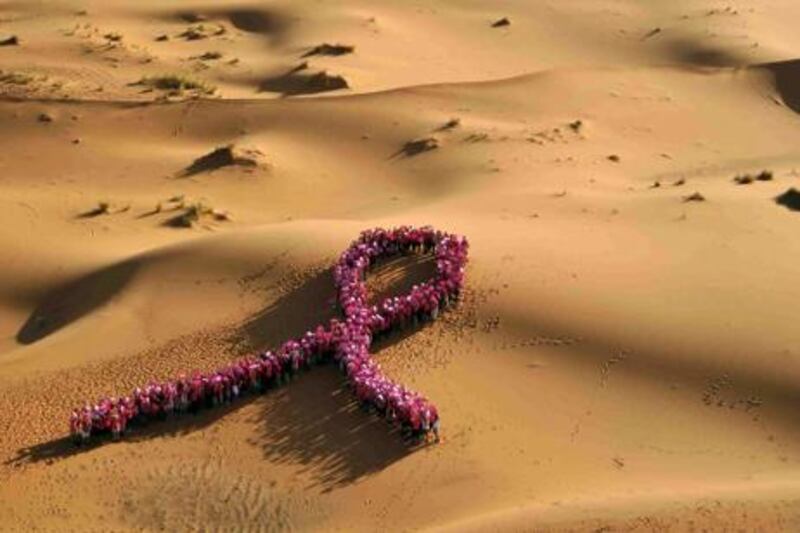It’s Breast Cancer Awareness Month and pink-ribbon products are everywhere you look, but some are starting to question whether they’re more about the cash than the cure.
There has been no shortage of ways to get into the “Pinktober” spirit – from the big, such as Estée Lauder Companies’ pink illumination of the Burj Al Arab and the Fairmont Bab Al Bahr in Abu Dhabi, to the small, such as pink-ribbon cupcakes at the Magnolia Bakery in Bloomingdale’s at The Dubai Mall.
A committed pink fan could head to the Sisters Beauty Lounge on a “pink” day for a free beauty upgrade, wrap herself in a pink scarf from S*auce boutique, take in a pink-themed polo match at the Ghantoot Racing and Polo Club and replenish fluids from her strenuous day with a water bottle by the sports brand Nathan, sporting an uplifting, awareness-raising message.
Around the world, products from lipstick to cars to teddy bears have been branded with the pink ribbon. KFC’s “Bucket for the Cure", a pink tub of fried chicken, may be the most widely ridiculed example – especially since a diet rich in fried meats has been associated with the disease.
All that pink is meant to remind women to get screened, encourage people to talk about breast cancer openly and raise money for breast cancer research and care. But Karuna Jaggar, the executive director of the US organisation Breast Cancer Action, argues that the ones who benefit the most are the companies doing brisk business in pink branded products.
“Companies have everything to win from pink-ribbon promotions,” Jaggar says. “We have crossed the awareness threshold.”
Raising awareness about breast cancer was a serious problem in the West decades ago, but today, you’d be hard pressed to find anyone still in the dark about it. All the pink hasn’t stopped breast cancer diagnoses from rising or mortality rates from stagnating, so it’s time to shift the focus away from raising awareness and toward finding out what causes it, Jaggar says.
But the situation is different in the Middle East, where treatment has not been as good and stigma has kept awareness behind.
Rana Danesh, the corporate communications manager for Estée Lauder Companies in the Middle East and India, pointed to the ways breast cancer treatment has improved and stigma has declined since pink campaigns started shining a light on the issue throughout the region – with her company taking the concept literally by illuminating global landmarks with the colour pink. There is more government support, investment in medicine, and treatment equipment has improved. People are also talking more about breast cancer in their workplaces and among their families, she says.
“We hope that seeing the landmarks in a vibrant pink light will encourage and remind women and their families to practice breast health and spread the message,” she says. “More people are talking about it.”
Samantha King, the author of Pink Ribbons Inc: Breast Cancer and the Politics of Philanthropy, a critique on pink-ribbon breast cancer culture, is also a professor at Queen's University in Kingston, Canada. She says the biggest success of the movement has been making breast cancer an everyday topic and a household name. Stigma is still a big problem, even in the West – about a quarter of husbands leave their wives after a breast cancer diagnosis – but it's no longer the shameful secret it once was.
“Certainly one of the more positive aspects of the emergence of this pink-ribbon industry and culture, I think, is it has enabled women to be more open about their -diagnoses.”
However, the culture of breast cancer walks for the cure and pink-ribbon everything can leave women feeling left out or exploited, King says. “It’s really hard to speak up against it because women feel like they’re being ungrateful. ‘Look, we’re raising all this money in your name'.”
Just how much money is being raised in their name is another point of contention. There’s no standard for companies selling pink-ribbon products – some donate a portion of the proceeds to breast cancer charities, some donate a fixed amount that isn’t affected by sales and some are raising awareness only.
King said consumers should look for the fine print and if there isn’t any, take a pass.
“I don’t believe we’re going to overcome a disease that’s linked to consumer lifestyles and environmental toxins by encouraging people to buy more stuff,” she says. “If we really want to give money, it’s better to give it directly to organisations we support rather than filtering it through large corporations.”






